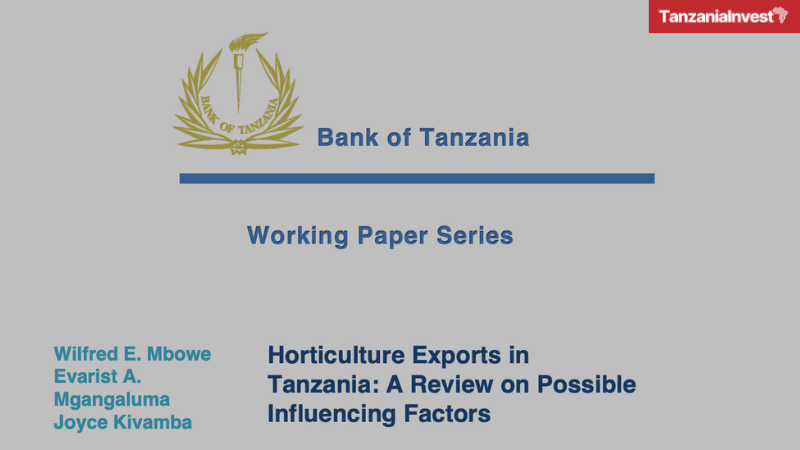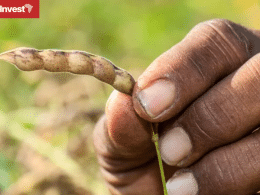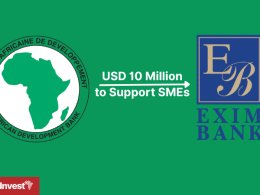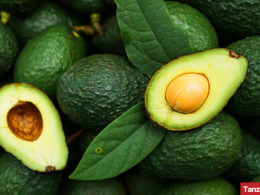The Bank of Tanzania (BoT) has published a study titled Horticultural Exports in Tanzania: A Review of Possible Influencing Factors, assessing the performance of the sub-sector and identifying factors influencing its growth.
The report shows that horticulture is among the fastest-growing agricultural sub-sectors in Tanzania, recording an average growth rate of 4.9% over the eight years leading to 2019.
Its share of total agricultural exports increased to 33.5% in 2020 and 38% in 2022. The sub-sector employs about 4.5 million people, though 90% of the produce is consumed domestically, highlighting significant untapped export potential.
Export Trends and Key Products
The study reveals that horticulture exports have developed in two phases. Between 2008 and 2013, export levels remained low. From 2014 onwards, exports experienced a marked upward shift in both value and contribution to foreign earnings, attributed to a more favorable business environment.
However, this growth has been accompanied by high volatility, largely due to unstable unit prices and inconsistent supply. Exports are dominated by high-value vegetables, which accounted for 74% of export value between 2014 and 2022. Flowers followed with 13%, while fruits and seeds grew more slowly, reaching USD 23.3 million and USD 15.05 million, respectively, in 2022.
The report also notes that while fruit production dominates horticulture output, it lags in export earnings. Flower production, meanwhile, suffered a sharp decline between 2019 and 2020 due to the COVID-19 pandemic.
Constraints Affecting Growth
The BoT study identifies a wide range of structural and operational constraints affecting horticulture exports.
Unpredictable production growth and reliance on smallholder, rain-fed farming expose the sector to seasonality and climate risks. Low productivity, driven by traditional practices, limited irrigation, and the use of unimproved seeds, further limits competitiveness.
Tanzania also records very high post-harvest losses, estimated at 40% of total crop output. Losses are linked to inadequate handling, poor storage, inappropriate transport, and lack of standardized packaging.
The study points out that northern regions such as Arusha, Kilimanjaro, and Tanga, traditionally strong performers, have reached land capacity. Future growth is expected from the Southern Highlands and Coastal regions.
Domestic markets remain uncoordinated, forcing smallholder farmers into weak bargaining positions due to information gaps and reliance on informal supply chains. Contract farming remains rare, at only 9.7% of respondents, mainly due to difficulties with quality control and contract enforcement.
Value addition is limited, with avocado being a notable exception. Product competitiveness is also weakened by poor seed quality, pests, cargo handling issues, and lengthy export procedures. Farmers face difficulties meeting international standards due to high costs and limited availability of certification services.
Market access and diversification remain limited. In the five years to 2019, only 0.5% of Tanzania’s horticultural production was exported. Exporters face inadequate cargo flights, limited cold room capacity at airports, and reliance on Kenya for logistics, raising costs and reducing brand recognition.
Most traders rely heavily on traditional markets and foreign agents, with 67.7% depending on external intermediaries.
Transport and Logistics Infrastructure
The study highlights significant gaps in transport and logistics. At Julius Nyerere International Airport, the 750sqm cold storage lacks international certification and adequate capacity. Kilimanjaro International Airport’s facility is over 15 years old and has limited holding capacity. Songwe Airport lacks a cargo terminal and certified handlers, while Mwanza Airport’s new terminal failed to meet aviation standards.
Air transportation is underutilized, with only 8% of flowers, 14% of vegetables, and 26% of fruits transported by air. Exporters face frequent cargo delays, clearance bottlenecks, and outdated infrastructure.
Policy and Regulatory Challenges
Despite several supportive policies, including the National Agriculture Policy (2013), the National Horticulture Development Strategy (2021-2031), and the AGOA Strategy (2016), the sub-sector continues to face challenges linked to weak enforcement, fragmented institutional support, and insufficient legislative backing.
Exporters also cite high costs from multiple taxes and fees, including a 2% withholding tax on inputs, corporate tax of 30%, Skills Development Levy of 3.5%, VAT on seed research, land rents, and numerous local government authority fees.
Peer Country Experiences
The study compares Tanzania’s performance with peer countries.
Kenya has attracted large foreign direct investment, expanded irrigation, developed robust logistics and storage facilities, and maintains frequent export flights to Europe. Supportive government policies and compliance with EU standards have reinforced its competitiveness.
Ghana has achieved high productivity through effective post-harvest management, reducing losses to around 20%. The country has invested in value addition and a world-class fruit terminal with cold storage.
Ethiopia has promoted large-scale private sector investment in flowers, supported smallholders with irrigation and inputs, and aligned closely with international quality standards.
Policy Recommendations
The BoT study calls for a series of interventions to unlock the full potential of horticulture exports.
These include scaling up irrigation systems, improving access to seeds and pesticides, and increasing budgetary allocations to agriculture. The report recommends upgrading logistics infrastructure, acquiring medium-sized cargo planes, enhancing cargo clearance efficiency, and expanding rail connectivity to ports.
It also highlights the need to expand market access through trade negotiations, direct linkages with buyers, and increased foreign investment.
Diversification into high-value crops such as avocado, cloves, black pepper, and cardamom is encouraged.
Improved awareness of international standards and certification processes, digital market linkages, and branding of Tanzanian horticulture products are also emphasized.
Finally, the report calls for stronger institutional coordination, including establishing an apex body to bridge gaps between producers, markets, and policymakers.










